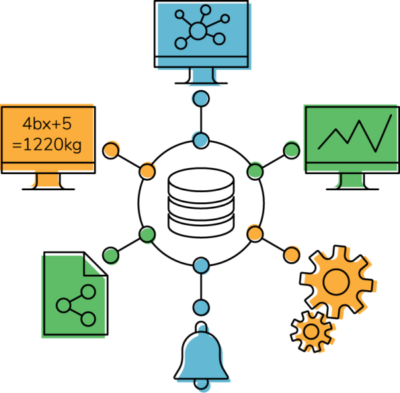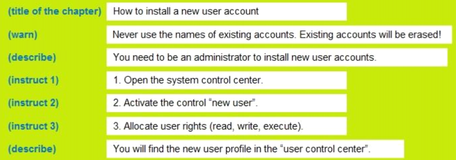Mr. Maier is an experienced technical writer in a medium-sized mechanical engineering company. Over the years the company and therefore also the products have been developed further: The idea "standard solutions" does not exist anymore. More complex solutions are requested, and in different variants. The company has changed to the motto "flexible but fast". In the meantime, Mr. Maier updates and creates new manuals with the help of Copy & Paste.
A further difficulty is that Mr. Maier must translate the documentation into various languages again and again because the German and English versions are no longer enough. Another problem is the different standards that must be observed depending on the country of the end user.

All the rewriting and adapting means work and time. Mr. Maier can only do this in a team.
And as if all that work was not enough... Customers are now not only asking for instructions. The requirements are:
• Layout with different logos
• Training documents
• Multimedia formats
• Online help
• HTML instructions
But how???
In the meantime, Mr. Maier looses control of the whole situation. The originals and translations are available in different formats. The translation costs are high and the conversion into digital
formats is very time consuming.
Now the weekend is coming up and the sun is shining. But... one of the most important customers of the company sends a report on Friday afternoon with some errors in the technical
documentation. After a short discussion with his colleagues, Mr. Maier identifies 10 paragraphs on a total of 5 pages which should be changed. That is quickly done! The sales department has
therefore assured the customer that the existing documents will be available on the company portal by Monday morning.

But that's not possible! Mr Maier cannot trace back in which documents this error first appeared. In which formats, versions, variants, markets was the faulty document reused? And even if he were able to correct everything, how would they handle the translations?
Mr. Maier works through the whole weekend and is now looking for a permanent solution. Is there any software that could solve the problem?
But what does such a solution look like?
The keyword is Information 4.0.
Modularisation 4.0
Uncontrolled errors in the technical documentation
Mr. Maier spent the entire weekend working to correct errors in the existing documentation of one of their biggest customers. He spent hours revising the documentation using Copy & Paste.
On Monday morning Mr. Maier was still working on it and the translations were still missing! His boss was anything but enthusiastic. And that increased the frustration even more. As Mr. Maier could not find any editing software on the market that could quickly solve the management of changes, he decided to think about the way technical documentation works:
Single source content

And then he came up with the solution: the problem is that he had not created any high-quality original content for years. And why? Copy & Paste and time pressure.
As a result, new content was often written instead of reusing it. This resulted in unnecessary translation costs and was not necessarily beneficial to the quality of the documentation. That means
inefficiency.
The solution is called Single Source Content:
Each original content exists once and is not duplicated but combined with other original content to create different documents.
Can this be done without changing the software?
Modules and fragments
After a few attempts, one thing is certain: The principle of single-source content is inevitably combined with the generation of independent content modules that can be flexibly assembled.

The first practical problem is the amount of information contained in each module. Some very long blocks of information (e.g. some standard chapters) are completely reused and have several
pages.
However, Mr. Maier notices directly that this approach cannot be implemented with the current software. To create modules in their software, he therefore decides to reduce the modules to one page. Fragments are unfortunately not possible. But: Not all modules are exactly one page long. Therefore, some pages are half empty. The layout is therefore not very reader-friendly.
A Puzzle

Mr. Maier would now like to go one step further. He would like to save and catalogue the modules in folders.
Thanks to the new folders and subfolders, Mr. Maier can now find and reuse the individual modules.
But creating and organizing the modules is very complicated. That is why Mr. Maier thinks about how to integrate metadata and taxonomies into his system.
Use case 4.0
Mr. Maier has created a folder structure. Now he wants to define metadata. These are properties that defines the modules. He thinks about it. He gives clear names to the modules, the folders also get names. The names go from the product line to the item number. Thanks to these names, also called metadata, he can now easily compile his documentation.
But he wants to go away from the old system and automate the documentation. That's why he has started to search for different systems and he already has several offers. But most of the software vendors have not given a real final price. They point out that a use case is necessary to define the requirements.

Mr. Maier calls the marketing department. They analyse the existing problems using a table:
• Many general texts in different manuals
• Product configurations that have a minor impact on the overall document
• Options that the customer can select
• Different formats - PDF but also Web
• Automatic correction of the single-source nodes
• Versioning
• Deviations due to different markets
• Translation management
• Terminology
But what does that mean?
Mr. Maier tries to answer:
|
Questions |
Answers |
|
Many general texts in different manuals
|
· Yes - so far always Copy & Paste |
|
Product configurations that have a minor impact on the overall document
|
· Yes - eventually. |
|
Options that the customer can select
|
· Yes, we have options. |
|
Different formats - PDF but also web
|
· At the moment we publish everything in PDF. · Other formats would be helpful. |
|
Automatic correction of the single-source nodes
|
· Single source, but no automatic correction. |
|
Versioning
|
· Manually |
|
Changes due to different markets
|
· Europe/America/Asia |
|
Translation management
|
· Our translation agency takes care of the translations. We do not have any idea about the costs. |
|
Terminology
|
· We have some term lists. |
He sends his answers to all software vendors. One software vendor answers promptly and offers a free trial.
Mr. Maier is pleased. He answers and asks for a test version. While he sets up the test version on his computer, Mr. Maier gets another e-mail with further questions and the suggestion of a
demo.
|
Questions |
Answers Markus F. |
Software Provider |
|
Many general texts in different manuals
|
Yes - so far always Copy & Paste |
|
|
Product configurations that have a minor impact on the overall document |
Yes - eventually. |
· Where do the technical data come from? Do you use a PLM in your company? · How are your product configurations created? Do you have a configurator? |
|
Options that the customer can select
|
Yes, we have options. |
· Are the options standard options? · Does each option have standard texts? |
|
Different formats - PDF but also web
|
At the moment we publish everything in PDF. Other formats would be helpful. |
· What software are you currently using? · Do you have standard layouts? |
|
Automatic correction of the single-source nodes
|
Single source, bur no automatic correction. |
Possible through reuse. |
|
Versioning
|
Manually |
· Do you have an exact workflow? |
|
Changes due to different markets
|
Europe/America/Asia |
· Textual differences? · Pictures? |
|
Translation management
|
Our translation agency takes care of the translations. We do not have any idea about the costs. |
· What languages do you translate into? |
|
Terminology
|
We have some term lists. |
· Would you like an authoring help for more brand identity? |
Test-System
In the meanwhile Mr. Maier has set the test system up. The system is connected to MS Word and has macros that automatically create the document in MS Word. He imports his nodes. Now he wants
to set up metadata and taxonomies. There is no real function for this. He can do it using only the folder structure and file names.
With the help of templates, he can now reuse his nodes and MS Word automatically creates the document, but somehow it takes a lot of time.
And now he is importing the translations. The system works pretty good. But you have to revise the translations afterwards in MS Word, because every language has a different length.
For the moment he has an example layout for the CCMS publication. But, he is considering whether the documents can be created in other layouts as well. That would be great of course! He contacts
the software provider. The answer comes immediately:

"No, you must choose one layout!"
But Mr. Maier does not always want to publish only in PDF in the same layout.
He would like to know more about:
• Filter
• Dita
• iiRDS
• Videos in technical documentation
• Integrations with other systems
• XML
• Workflow
• Versioning
Style guide 4.0
The test system works. But Mr. Maier is thinking: If I import my documents into a CCMS, not only in a clear structure is necessary, but I must write according to writing rules. Did the providers said something about authoring assistance?
Rules are everything!
Mr. Maier would like to concentrate on grammatical and stylistic rules first. After a long search he finds the rules of Simplified Technical
English and the guideline "Rule-based writing" of the German association of technical communication TEKOM. He buys both editions and reads them.

In the case of Simplified Technical English, there is a basic dictionary with permitted and prohibited words. There are also clear rules for writing regarding:
• Grammar
• Structure
• Length
Technical terms are divided into different categories. "Terminology," thinks Mr. Maier. If he learns to apply Simplified Technical English, he could write the documentation directly in
Simplified Technical English.
He takes a translated text and tries to rewrite it according to the rules. It takes quite a lot of time, but the before and after effect is clearly visible:

In the meantime, he now wants to define some basic rules.
Guide on style

If the operator must do something, the technical writer must use the imperative. Then it is clear to the operator that it is his job to implement.
For a task he defines the following rules:
• Use numbered list.
• Use imperative.
• Use introductory sentence before the numbered list.
• Explain the result after completing the numbered list.
“It is like a sandwich!” Mr. Maier thinks.
Titel
The titles must be short, explanatory and clearly structured.
Verbal titles are easy to understand.
Example:
|
Bad |
Good |
|
Installation of a driver |
Installing the Driver |
|
How I set up the PC |
Setting up the PC |
There are different approaches in the TEKOM guideline. It is important to decide on one method and to apply it consistently. Mr. Maier appreciates this approach and combines it with STE.
Title and subtitles
Unnecessary repetitions must be avoided in the title structure. Otherwise the titles are not reader-friendly and the structure is not always clear.
|
Bad |
Well |
|
1. Machine operation |
1 Operating the machine |
|
1.1 Machine operating parameters |
1.1 Setting parameters |
|
1.2 Preparing the machine for operation |
1.2 Preparing the machine |
Well-structured and organized titles help the operator to find his way through the manual. Do not forget this rule. The titles define the basic structure of
a document.
Pronouns
In contrast to books, you should not use pronouns in technical communication. Pronouns can lead to misunderstandings.
|
Bad |
Good |
|
The man takes the dog Snoopy for a walk. He's old.
QUESTION: Who's old? The man or the dog Snoopy? |
The man takes the dog Snoopy for a walk. The man is old.
Now it is clear that the man old. |
Prepositions
Technical communicators often leave out prepositions. Then writing is faster and space is saved. But then the reader has no references in the text. This can be misleading.
|
Bad |
Good |
|
Oil Brake Wheel
QUESTION: Is the oil for the wheel or for the brake? |
Oil for wheel brake
Now it is clear what the oil is used for. Furthermore, the compound noun helps to understand better. |
PassivE
Passive sentences leave the doubt about who must do something. Passive sentences should be avoided in technical writing. The operator must know what he must
do. We must exclude interpretation possibilities!
|
Bad |
Good |
|
The machine must be switched off.
QUESTION: Who turns off the machine? |
Switch off the machine.
Thanks to the imperative the reader knows that he must switch off the machine. |
Writing style
But numbered lists are not really grammar. As a next step, Mr. Maier would like to analyse the structure and the layout.
Short sentences
Nested sentences are usually incomprehensible. The reader must read the sentence several times. Especially in a descriptive text the technical communicator
should pay attention to the text length. As a thumb rule you could set a maximum of 20-25 words / sentence.
|
Bad |
Good |
|
The machine is a printing machine which may only be operated by very well trained persons who have been trained in this field and have had at least 5 years of experience, in order to prevent faulty productions or production downtimes. |
Only trained personnel with 5 years of professional experience can use the machine. This prevents errors during production as well as production downtimes. |
The structure and sequence of the sentences must be logical and correspond to the operation sequence.
Lists:
Both numbered and bullet point lists must be uniform:
• Define if to start with capital letters or not.
• Define the punctuation.
• Do not interrupt sentences.
|
Bad |
Good |
|
The operator must switch off:
|
The operator must switch off the following:
|
In our example we have a complete introductory sentence. Do not use articles to avoid accusative problems during translation. Start with a capital letter in the list. Omit commas and add a full
stop at the end the list.
These rules are only suggestions. The technical writer must define clear writing rule to guarantee consistent texts.
Style:
And t you can also save on translation costs:
|
Bad |
Good |
|
Press the key. |
Press the key. |
|
Press the button. |
Press the key. |
|
Press down the push button. |
Press the key. |
|
Push the button. |
Press the key. |
Now Mr. Maier would like to define the technical terms, as in STE.
In our next blog, Mr. Maier is looking for a system that combines terminology and technical writing and different layouts and formats in one CCMS.

Write a comment